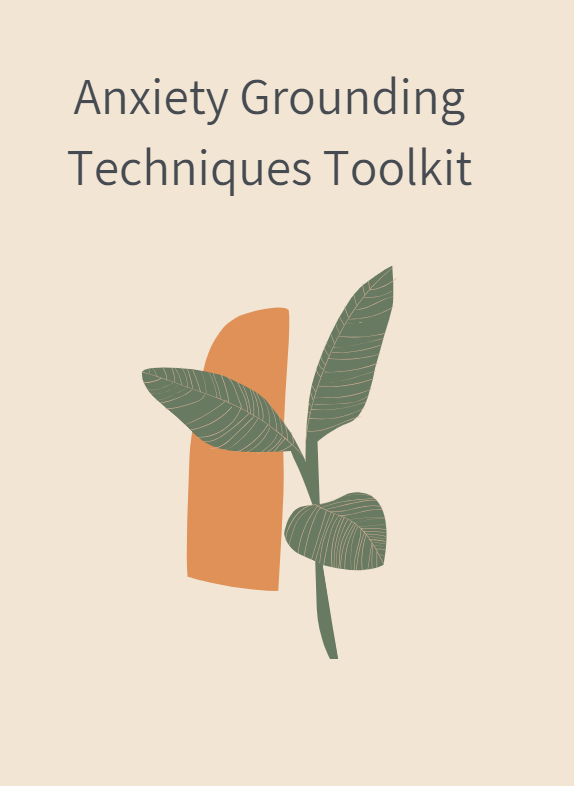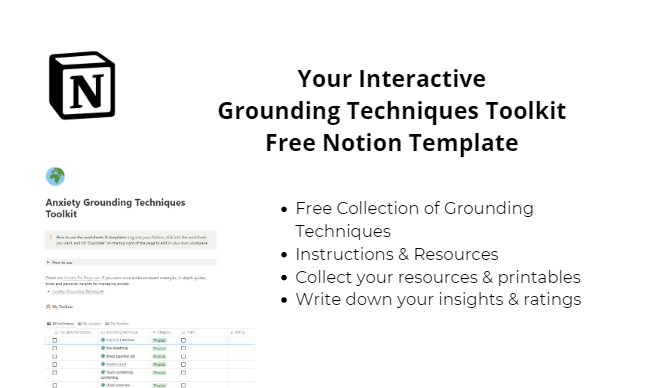Anxiety can bring with it overthinking or intrusive thoughts. But now, enter Grounding Techniques: techniques that help you lower your anxiety by bringing your focus and awareness to the present moment. These techniques are efficient, available anytime and anywhere, and free. Download our Grounding Techniques for Anxiety PDF Guide to discover effective strategies to help manage and alleviate anxiety symptoms.
What are Grounding Techniques?
Grounding techniques are techniques and strategies that can help you lower your anxiety by making you focus on the present moment, instead of your thoughts and worries.
Grounding Techniques Are Backed Up By Science
It is proven that focusing on a distracting task or activity is more effective at reducing intrusive thoughts than actively trying to suppress those intrusive thoughts (1).
There are three categories of grounding techniques:
- Physical
- Mental
- Emotional
You can implement these techniques into your daily life, as they are free and very easily accessible.
How to Use Grounding Techniques
Effectively harnessing grounding techniques involves a mindful and personalized approach.
Step 1: Awareness
Recognizing when anxiety is starting to kick in, manifesting in your thoughts, emotions, and physical sensations. Once you sense anxiety’s presence, choose a grounding technique that resonates with you from the categories we’ve mentioned: physical, mental, or emotional. It’s best to try doing a grounding exercise when you first start to feel bad, and not waiting until it feels like it’s too much to handle.
Step 2: Experimentation.
Experiment with different techniques to discover which ones work best for you. When applying a chosen technique, focus your attention entirely on it. For instance, if you opt for sensory grounding, immerse yourself fully in the sensory experience, whether it’s the texture of an object or the aroma of a scent. In physical grounding, engage in the chosen physical activity with intention and presence.
Step 3: Practice
Consistency is key—practice these techniques regularly to build resilience and familiarity. Remember that what works best can vary from person to person, so personalize your toolkit with the techniques that better work with you.
Further Tips and Tricks
- You can make a sensory box and keep it in your bedroom or where you need it the most. Use items of different textures, smells, or photographs.
- You are trying to take distance with your thoughts, not connect with them. Don’t journal or talk about your negative feelings during this time. Also, try to use neutral statements. For example, say “This room is cold” instead of “This room is so cold because it is winter and I do not like winter”.
- You can change the grounding exercises as you want, and create your methods of grounding
- Try to record in your toolkit which techniques work for you.
- If you need it or if you feel like grounding isn’t working, try it for longer periods, such as for 30 minutes.
Anxiety Grounding Techniques Toolkit
Physical Grounding Techniques
- 5-4-3-2-1 Method: Ground yourself by identifying five things you can see, four things you can touch, three things you can hear, two things you can smell, and one thing you can taste. You can always change it, and choose five things you can touch for example.
- Smell a scent: You can smell lavender to relax, or turn some aromatic candles on. You can try other smells such as citrus (you can bite into a lemon), coffee, or peppermint. Spray yourself with some perfume.
- Smell essential oils: Use calming essential oils like lavender or chamomile.
- Touch something comforting: Hold or touch a comforting object like a soft blanket or a stuffed animal. Describe how it feels. Notice textures, colors, materials, weight, temperature.
- Drink some tea: (or just enjoy the smell), savor the taste and smell, and feel its temperature.
- Temperature: Pay attention to the temperature around you, noting warmth or coolness on your skin. You can try taking a hot shower.
- Go in nature: Hear the birds chirping, the wind blowing, the colors around you. Touch some grass, hug a tree.
- Feel the sun: Go out to the sun and focus on how hot you are. Feel the warmth in your skin.
- Put your hands in water: Immerse your hands in warm or cool water.
- 4-7-8 breathing: Regulate your breath with the 4-7-8 technique (inhale for 4 seconds, hold for 7 seconds, exhale for 8 seconds) to reduce anxiety.
- Deep (Balloon) Breathing: Count to 4 as you breathe in, hold for 4, and exhale for 4. As you inhale, notice your lungs expanding with air, and as you exhale, your lungs shrink. Check out our guide to box breathing.
- Take a short walk: Step outside for a walk to change your environment and get fresh air. The temperature difference can also help you, for example, if it is chilly outside.
- Hold a piece of ice: Ground yourself through the sensations of cold by holding an ice cube.
- Play with a stress ball: Squeeze and release a stress ball to release tension.
- Wrist stretch: Relieve physical tension by gently stretching and rotating your wrists.
- Grounding yoga poses: Practice grounding yoga poses such as Child’s Pose or Mountain Pose.
- Physical activity: Engage in short bursts of physical activity, like doing push-ups or jumping jacks
- Tapping EFT: Try Emotional Freedom Techniques (EFT) by tapping on specific points on your body to release emotional stress. Read more on the Tapping Technique for Anxiety.
- Rub your hands together: Feel the warmth traveling through your body while you close your eyes.
- Clap your hands: Feel the sensations of the clap, and how long it lasts.
- Stomping your feet on the ground: Feel the floor under you.
- Chew some gum: You can focus on the physical task, or you can also focus on the sensations and flavors.
- Splash your face with some cold water (or some warm water too)
- Pop bubble wrap
- Try a weighted blanket. Feel its weight, the texture.
- Doodle. Take a pen and just doodle.
Mental Grounding Techniques
- Counting: Divert your thoughts by counting backward from 100 or counting objects in the room
- Reverse countdown: Engage your mind by counting backward from 1000 in increments.
- Sudoku: Challenge your brain with Sudoku puzzles.
- Mental calculations: Perform mental calculations or math exercises to redirect your thoughts, such as multiplication tables.
- Memory game: Improve memory and focus by playing memory games or recalling movie scenes in detail.
- Think in categories: Organize your thoughts by categorizing objects or ideas.
- Describe a common task: Verbally describe a common task in detail to refocus your mind
- Describe what is around you: Enhance awareness by describing your environment.
- Distract yourself: Fully engage your attention with an absorbing activity like a puzzle or hobby
- Read words backward
- Say the alphabet
Emotional Grounding Techniques
- Noting meditation: Try the noting meditation technique or mindful meditation
- Focusing on your breath: Cultivate mindfulness by focusing on your breath, counting each inhalation and exhalation.
- Guided imagery: Immerse yourself in guided imagery or visualization exercises to transport your mind to a calming mental space.
- Have an anchor object. Have an anchor object that reminds you of the present moment. It can be a bracelet, a photograph, a clay figure, whatever you want.
- Listening to music: You can listen to relaxing songs or just some songs you like. Try the song Weightless by Marconi Union, called the ”most relaxing song in the world”. You can also try dancing which gives you the benefit of putting your body into motion.
Grounding Techniques for Anxiety PDF – Free
Anxiety Grounding Techniques PDF Toolkit
The Anxiety Grounding Techniques PDF Toolkit is a comprehensive resource that provides a variety of effective techniques to help manage anxiety. Download the toolkit for practical tools and strategies to ground yourself during moments of anxiety, as well as free interactive tools.

Interactive Anxiety Grounding Techniques Toolbox – Free
Interactive Anxiety Grounding Techniques Toolkit
Introducing the “Anxiety Grounding Techniques Toolkit” Notion template – your comprehensive resource to manage and alleviate anxiety.

✨ Key Features ✨
Library of Anxiety Grounding Techniques: Explore diverse grounding techniques for physical, mental, and emotional well-being. 🧘♂️🧠💖
Resource Tracker: Keep all your tips and resources organized for each technique. 🗂️
Personal Toolbox: Customize your toolkit, tracking tried-and-true favorites with ease. 🧰
Use Grounding Techniques for Anxiety Now
Grounding techniques help you stay grounded, centered, and connected to the present, allowing you to regain control over your thoughts and emotions.
We encourage you to explore and incorporate these techniques into your daily life, as they have the potential to bring calm and clarity to even the most anxious moments. Don’t forget to download our Grounding Techniques for Anxiety PDF free Toolkit for quick and easy reference.
If you are interested in more thought-stopping techniques, we recommend you check out our guide on Distraction Techniques for Anxiety.
Get it for FREE onSources
(1) Lin, Y.-J., & Wicker, F. W. (2007). A comparison of the effects of thought suppression, distraction and concentration. Behaviour Research and Therapy, 45(12), 2924-2937. https://doi.org/10.1016/j.brat.2007.08.004

Leave a Reply